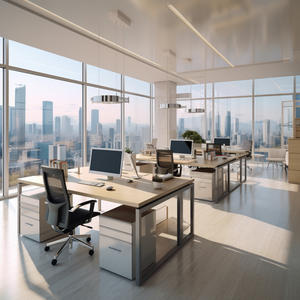Intro
In the world of business, the balance between cost and quality is often a tough line to walk. This becomes strikingly evident when we talk about office furniture. The longevity and durability of office furniture play a critical role in shaping the workplace experience and managing costs, making it a significant consideration for any business. This article explores the conundrum of choosing between high-quality new office furniture and cheaper alternatives, ultimately showcasing used office furniture as the sweet spot between quality and price.
High-Quality New Office Furniture: A Pricey Proposition
New, high-quality office furniture is an enticing prospect. It's durable, built to last, and typically comes with warranties that offer peace of mind. In addition, it often has ergonomic features and aesthetic appeal that contribute to a positive work environment.
However, this option is not without its drawbacks. The most noticeable is the high cost. Premium office furniture can command hefty price tags that can be a significant burden, especially for startups and small businesses. Also, the immediate depreciation in value once the furniture is used is another downside that businesses have to absorb.
Cheap Office Furniture: An Illusion of Savings
On the opposite end of the spectrum, cheap office furniture offers initial cost savings that can be very attractive, particularly for businesses operating on tight budgets. The reduced upfront costs can help companies allocate more funds towards operational growth and other strategic initiatives.
However, the old saying, "you get what you pay for," often holds true. Cheap office furniture typically has a shorter lifespan and requires more frequent replacements or repairs, driving up costs over time. Furthermore, low-cost furniture might not provide the ergonomic design and comfort necessary for productivity, leading to potential decreases in workforce efficiency.
The Sweet Spot: Second-Hand Office Furniture
Navigating between these two extremes can be challenging, but there's a viable middle ground: second-hand office furniture. When a company opts for used high-end furniture, they get the advantage of durability and quality without the hefty price tag.
Second-hand office furniture often comes from businesses that are upgrading, moving, or closing down. This means that quality pieces, which have already proven their durability, are available at a fraction of the original cost.
Investing in used furniture does not mean compromising on quality. Second-hand furniture often comes from reputable brands known for their high standards of craftsmanship and durability. Consequently, you get the longevity of high-end furniture at prices that closely mirror budget options.
Moreover, the second-hand office furniture market also contributes to a circular economy. It promotes sustainability by extending the lifecycle of these products, reducing waste, and lowering the demand for new production.
Conclusion
In the tug of war between cost and quality, second-hand office furniture emerges as a clear winner. It presents a unique opportunity to acquire high-quality, durable pieces at a much more affordable cost. This solution not only provides immediate financial relief but also ensures long-term savings by minimizing replacement and repair expenses. For businesses striving to find a sweet spot between quality and price, the second-hand furniture market is an avenue worth exploring. To learn more about used office furniture, read our buying guide.

